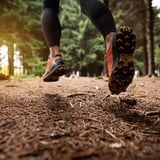Stiflingly hot temperatures can be enough to make even the most dedicated runner rethink their workout plans. And for good reason — running in the heat can be not just unpleasant, but in some cases even dangerous, and opting for the treadmill can sometimes feel like the only option to get some summer miles in. But depending on where you live, there might be another (significantly more fun!) way: the trails.
Trail running can keep you cooler thanks to the shade, higher elevation, and uneven terrain that encourages you to slow down. If you've never been trail running before, getting started isn't as intimidating as it may seem. Here's everything beginners need to know to conquer the trails and soak up that sweet, sweet shade.

Kat Drew is a running coach and professional ultrarunner for Arc'teryx . Heather Hart is a certified run coach and ultramarathoner. Johanna Aström is a professional trail runner for Arc'teryx.
How to Stay Safe While Trail Running If something goes wrong on the roads, you can call an Uber to come pick you up or duck into a nearby business to get help. On the trails, though? You could be far from civilization, without cell phone service. That's why running safety considerations are extra-important on the trails.
Before trail running, tell someone where you're going and approximately when you plan to be back, suggests Kat Drew , a running coach and professional ultrarunner for Arc'teryx . If possible, run with a buddy, too. Research your route in advance, and aim to start out with easier, less technical trails to help you get used to trail running terrain.
Also be sure that you have a map that'll be accessible even if you don't have cell service, whether that's a paper map or one downloaded to your phone prior to the run, Drew tells PS. Finally, stay aware of your surroundings. "If you have running music , leave one ear open and turn it down low," Heather Hart , a certified run coach and ultramarathoner, tells PS.
"You need to be aware of what's ahead of you and what's behind you, whether that's other people or wildlife. If you check out mentally listening to your music and blow by your turn, next thing you know, you're lost." Must-Have Trail Running Gear to Pack Maybe when you're road running, all you take with you is your phone and a house key.
But trail running often demands more gear, and when you're starting out, it's better to pack a little too much and deal with a slightly too-heavy pack than to find yourself without something you urgently need. Pack wisely for the length and location of your run. Consider bringing: Other products you may want to have on hand during your trail run: Opt For Trail Running Sneakers We're big believers in the fact that all you need to become a runner is a pair of running sneakers and a little willpower.
But the sneakers really do matter — not because you need a fancy pair to "count" as a runner, but because an inappropriate pair of shoes is one of the quickest ways to get injured. Unlike road shoes, which have mostly flat soles, trail shoes have lugs, designed to provide grip and traction on slippery rocks or muddy surfaces (think of them almost like the treads on a tire). Trail shoes also have a rock plate, to protect your foot against sharp rocks you might encounter, and a more-protective upper around the toes.
What trail shoes will work best for you largely depends on what kind of terrain you'll be running on, and your own feet and preferences. Your local running store should be able to help you find a pair that works for you. Forget Your Pace While Trail Running If you're used to training for road races and following workout plans, you probably use your pace to guide your runs, checking in every mile or interval to ensure you're on track.
On the trails, prepare yourself for a major mindset shift. "The number one thing I tell people going on the trails for the first time is don't look at your pace," says Hart. But just because you're running slower doesn't mean you're working any less hard.
It's more that the trails present unique challenges for your body: The often-softer surface (like dirt) doesn't allow you to push off with as much force as concrete, for example, plus there's rocks and roots to dodge and hills (or mountains!) to climb and descend. You'll likely even want to walk or power-hike the ascents, which is highly encouraged, says Hart. Let go of any specific mileage goals, too, says Aström.
"It's not relevant — it depends so much on how much up and down there is, and how technical it is," she says. In other words, five miles on the roads is rarely equivalent to five miles on the trails, so plan to be out for a designated amount of time instead, she suggests. Focus on keeping your pace easy, knowing that it'll probably be significantly slower than your "easy" pace on the roads.
Rather than letting that frustrate you, let it free you. "From an emotional and mental point of view, it can be so great to check out of the noise, get out into nature, unplug from your Garmin, and just enjoy being outside," says Hart. "It's a whole different experience for road runners who are super focused on their pace and distance — trail running can be an opportunity to let that go.
" Lauren Wingenroth is a freelance journalist covering all things sports, fitness, and the performing arts. In addition to PS, her stories can be found in The New York Times, GQ, Outside magazine, Women's Running, Well+Good, Dance Magazine, and more..

















